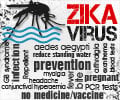New technique enables SHERLOCK to quickly and cheaply track pathogens such as Zika during an outbreak.
- New tool enables the CRISPR-based diagnostic SHERLOCK to detect viruses directly from body fluids.
- The expansion of the platform’s potential allows to quickly and cheaply track pathogens such as Zika and Ebola during an outbreak.
- The tool eliminates a processing step that previously required a lab environment and professionally trained personnel.
SHERLOCK and HUDSON
The CRISPR-based diagnostic platform SHERLOCK (Specific High-sensitivity Enzymatic Reporter unLOCKing) uses a programmed Cas13 enzyme along with reporter molecules to indicate the presence of a genetic target, such as a virus. Until now, extracting and isolating nucleic acids from patient samples was a crucial step in the process that required a lab and trained personnel, making it difficult to accomplish in the field. Now, the team has developed a simpler method that allows Cas13 to detect its target (eg. virus) directly in bodily fluid samples such as saliva or blood.The new tool that allows SHERLOCK to do this is called HUDSON, or Heating Unextracted Diagnostic Samples to Obliterate Nucleases. HUDSON consists of a rapid chemical and heat treatment that inactivates certain enzymes in the sample that would otherwise degrade the genetic targets.
The HUDSON processed samples can then be run through the SHERLOCK procedure. The results of the diagnostic test, positive or negative, can be easily viewed with the naked eye on specialized paper strips. Moreover, the entire process can be completed in under two hours.
What does the Sherlock update mean?
The update on SHERLOCK means that now clinicians will be able to quickly and cheaply diagnose patient samples and track epidemics such as Ebola and Zika with limited equipment, which was a major barrier to rapid deployment in outbreak zones.SHERLOCK can now be used to detect viruses directly from clinical samples such as blood or saliva. This eliminates a processing step that previously required a lab environment and professionally trained personnel.
This is a major advancement which will allow the use of SHERLOCK in areas where special training and clinical laboratories can be challenging to access.
Expanding the SHERLOCK platform
Distinguishing related viral species from one anotherThe team has designed SHERLOCK reagents which will make it easier and faster to distinguish multiple related viral species like Zika, dengue, West Nile, and yellow fever from one another. This will prove useful when a patient has general symptoms, such as a fever, that could be caused by more than one pathogen.
A user friendly diagnostic
The updated platform puts us even closer to a fast and user-friendly diagnostic that can be easily deployed anywhere.
"With every enhancement to the SHERLOCK pipeline, the diagnostic process accelerates and requires less equipment," says Catherine Freije, graduate student and co-author of the study. "We’re trying to make these tools better and easier to use so that the diagnosis can move closer to the patient, where it really needs to be."
Identify clinically relevant mutations
The platform is capable of identifying clinically relevant mutations such as a small mutation in Zika virus that has been associated with microcephaly.
The team aims to develop a framework to ensure the SHERLOCK platform is easily accessible in parts of the world where there is an urgent need for fast, inexpensive, reliable, field-based diagnostics.
References:
- Field-deployable viral diagnostics using CRISPR-Cas13 - (http://science.sciencemag.org/content/360/6387/444)













